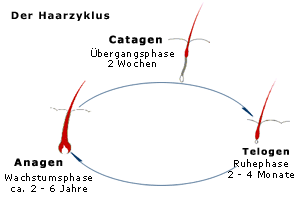Hair loss
Our lives depend on hormones. Of those, the sex hormones are of major importance, influencing almost every part of our physiology and our social life. Their levels change with age. In men, after reaching a peak in the twenties, their levels continuously decline. Women also produce male sex hormones – initially in very small quantities, but with years the levels increase so that after menopause, women actually may produce about as much male sex hormone as men do at that age [Price VH. 1999. Treatment of hair loss. N Engl J Med 341:964-973].
Hair loss in both men and women is most often caused by the effects of male hormones. After age 25, for reasons not yet explained, in genetically predisposed males, the male hormones start affecting the hair roots which slowly degenerate. This results in thinner hair which ultimately is pushed out of the hair follicle. A similar phenomenon occurs in predisposed women in a stage of life when they produce substantial levels of male hormones. There are also other reasons for baldness which dermatologists diagnose and often can treat, but by far the most prevalent is the condition caused by male hormones.
Average daily hair loss is 25 to 100 hairs, but most hair regrows because the hair follicle remains active. When shedding significantly exceeds hair growth baldness occurs.
Hair and its root structure

The hair root is located in the dermal layer of the skin and ends with the hair bulb just above the subcutaneous tissue layer. Through a small gap in its base, nerve fibers and blood vessels access the dermal papilla where new cells are continuously produced. To the upper region of the hair bulb region is attached the errector pili muscle which can raise hair. The sebaceous gland produces the hair fat.
The hair growth cycle

Hair growth occurs in a cycle of three main phases: Anagen, Catagen and Telogen.
Anagen phase (Growing phase)
The anagen is the active growth phase of hair. The cells in the lower region of the hair follicle proliferate and multiply. The new hair cells push upwards toward the skin’s surface, becoming keratinized and hardened. This phase can last 2-6 years.
Catagen phase (Regression phase)
The anagen phase is followed by the Catagen, or regression phase, which lasts about 20 days. The cells in the lower region of the hair follicle degenerate, and the dermal papilla, nerve fibers and blood vessels shrink.
Telogen phase (Resting phase)
The Telogen is also called the “resting phase”. With the absence of nerve fibers and blood vessels there is no stimulation of the dermal papilla and the hair stops growing. The dermal papilla then becomes isolated in the dermis and the old hair shaft can easily be expelled (i.e., by shampooing or brushing). Upon cellular regeneration the lower region of the hair follicle rebuilds and begins to produce new hair and the new hair follicle returns to its growing (anagen) phase.